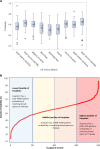Patterns, Predictors, and Intercenter Variability in Empiric Gram-Negative Antibiotic Use Across 928 United States Hospitals
- PMID: 35737945
- PMCID: PMC9907550
- DOI: 10.1093/cid/ciac504
Patterns, Predictors, and Intercenter Variability in Empiric Gram-Negative Antibiotic Use Across 928 United States Hospitals
Abstract
Background: Empiric antibiotic use among hospitalized adults in the United States (US) is largely undescribed. Identifying factors associated with broad-spectrum empiric therapy may inform antibiotic stewardship interventions and facilitate benchmarking.
Methods: We performed a retrospective cohort study of adults discharged in 2019 from 928 hospitals in the Premier Healthcare Database. "Empiric" gram-negative antibiotics were defined by administration before day 3 of hospitalization. Multivariable logistic regression models with random effects by hospital were used to evaluate associations between patient and hospital characteristics and empiric receipt of broad-spectrum, compared to narrow-spectrum, gram-negative antibiotics.
Results: Of 8 017 740 hospitalized adults, 2 928 657 (37%) received empiric gram-negative antibiotics. Among 1 781 306 who received broad-spectrum therapy, 30% did not have a common infectious syndrome present on admission (pneumonia, urinary tract infection, sepsis, or bacteremia), surgery, or an intensive care unit stay in the empiric window. Holding other factors constant, males were 22% more likely (adjusted odds ratio [aOR], 1.22 [95% confidence interval, 1.22-1.23]), and all non-White racial groups 6%-13% less likely (aOR range, 0.87-0.94), to receive broad-spectrum therapy. There were significant prescribing differences by region, with the highest adjusted odds of broad-spectrum therapy in the US West South Central division. Even after model adjustment, there remained substantial interhospital variability: Among patients receiving empiric therapy, the probability of receiving broad-spectrum antibiotics varied as much as 34+ percentage points due solely to the admitting hospital (95% interval of probabilities: 43%-77%).
Conclusions: Empiric gram-negative antibiotic use is highly variable across US regions, and there is high, unexplained interhospital variability. Sex and racial disparities in the receipt of broad-spectrum therapy warrant further investigation.
Keywords: antibiotic stewardship; empiric therapy; gram-negative antibiotics; inpatient antibiotic utilization.
© The Author(s) 2022. Published by Oxford University Press on behalf of Infectious Diseases Society of America.
Conflict of interest statement
Potential conflicts of interest. A. D. H. reports personal fees from UpToDate, outside the submitted work. E. L. H. reports consulting for Wolters-Kluwer (Lexi-Comp), outside the submitted work and paid to author. R. D. and L. P. are employees of Merck Sharp & Dohme LLC, a subsidiary of Merck & Co, Inc, and both report stock or stock options from Merck. M. S. reports stock or stock options with Microsoft Corporation. All other authors report no potential conflicts. All authors have submitted the ICMJE Form for Disclosure of Potential Conflicts of Interest. Conflicts that the editors consider relevant to the content of the manuscript have been disclosed.
Figures




References
-
- World Health Organization . WHO publishes list of bacteria for which new antibiotics are urgently needed.2017. Available at: https://www.who.int/news/item/27-02-2017-who-publishes-list-of-bacteria-.... Accessed 25 January 2022.
-
- Centers for Disease Control and Prevention . Antibiotic resistance threats in the United States. 2019. Available at: https://www.cdc.gov/drugresistance/biggest-threats.html. (Last accessed 29 June 2022).
-
- Centers for Disease Control and Prevention . Core elements of hospital antibiotic stewardship programs.2019. Available at: https://www.cdc.gov/antibiotic-use/core-elements/hospital.html. Last accessed 29 June 2022.
Publication types
MeSH terms
Substances
Grants and funding
LinkOut - more resources
Full Text Sources
Medical

